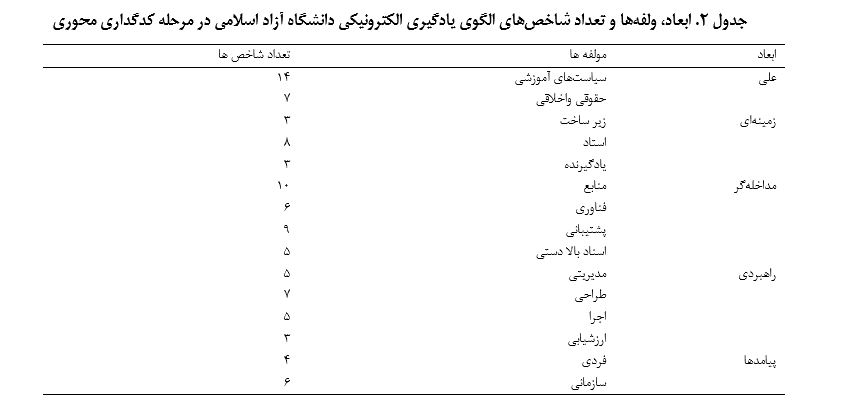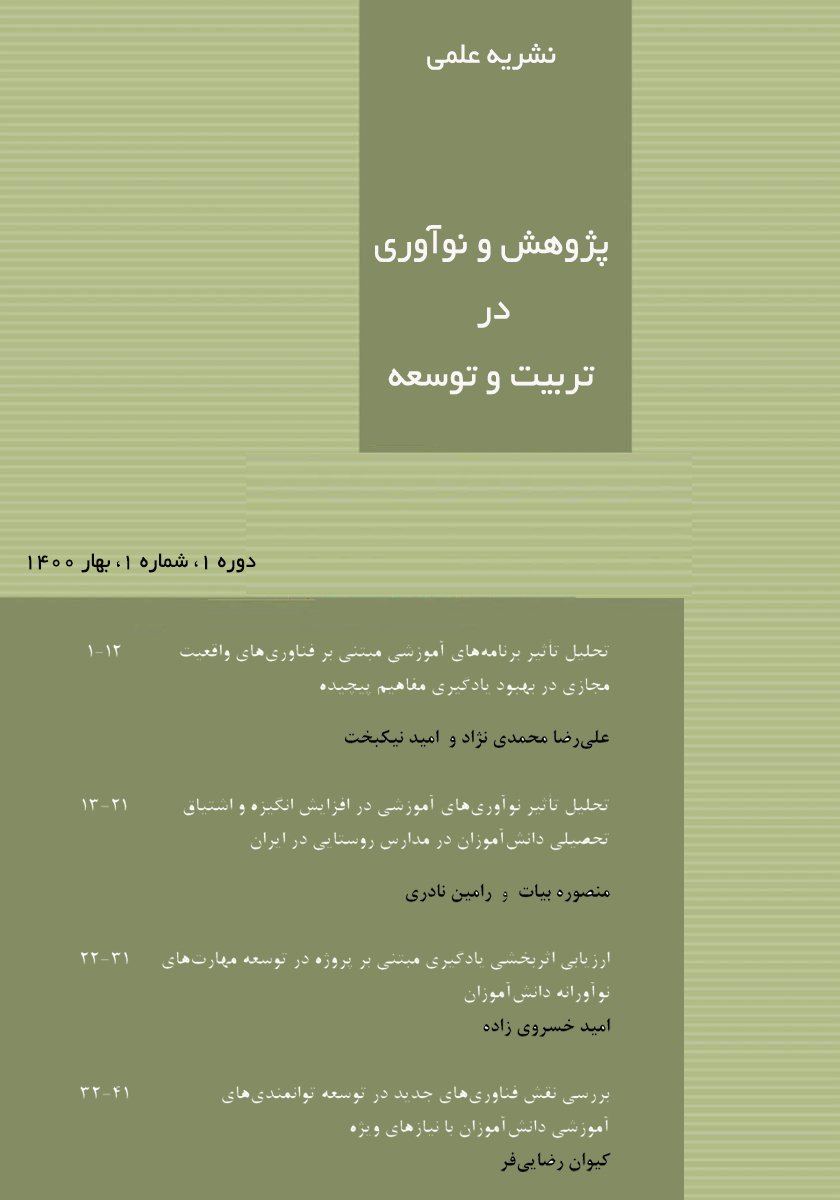طراحی الگوی یادگیری الکترونیکی دانشگاه آزاد اسلامی (مورد مطالعه: دانشگاه آزاد اسلامی شهرستان بوشهر)
کلمات کلیدی:
یادگیری الکترونیکی , عوامل علی, مداخله گر, شرایط زمینه ای, راهبردها, پیامدها, برون دادهاچکیده
هدف پژوهش طراحی الگوی یادگیری الکترونیکی دانشگاه آزاد اسلامی شهرستان بوشهر است. روش پژوهش از نظر هدف، کاربردی و از نظر نوع داده کیفی و از نظر ماهیت و نوع مطالعه داده بنیاد سیستمی (پارادایمی) است. جامعة مورد نظر پژوهش شامل خبرگان حوزه مدیریت ومنابع انسانی میباشد، که بر اساس روش نمونهگیری آگاهانه از نوع نظری و بر اساس اشباع نظری، 15 نفر خبره برای مصاحبه انتخاب شدند. ابزار پژوهش مصاحبة نیمهساختاریافته بود که در آن، ابعاد، مؤلفهها وشاخصهای الگوی یادگیری الکترونیکی دانشگاه آزاد اسلامی شهرستان بوشهرتنظیم شد. برای فرم مصاحبة یادشده ابتدا مصاحبه عمیق باخبرگان انجام شد سپس، با کدگذاری باز، شاخصها احصا شدند و از طریق کدگذاری محوری، در قالب مؤلفهها و شاخصها مقولهبندی شد، و برای 15 نفر از خبرگان ارسال و به کمک کدگذاری انتخابی از طریق مصاحبه، و بارش فکری مؤلفهها وشاخصها نهایی شد. در نتیجه، 5 بعد، ۱۶ مؤلفه و ۱۰۱ شاخص برای الگوی یادگیری الکترونیکی دانشگاه آزاد اسلامی استان بوشهر نهایی شد. پس از تأیید نهایی و اولویتبندی توسط خبرگان، ابعاد، مؤلفهها و شاخصهای سازندة الگو ترسیم شده و مجدداً الگوی یادشده توسط خبرگان اعتباریابی شد.
دانلودها
مراجع
Alipour N, Norouzi D, Nourian M. Designing a Model for Factors Influencing the Quality of E-Learning
Environments. Educational Technology Quarterly. 2021;15(3):503-18.
Hafizi A, Mofakhami A, Basharatnia MS. The Importance and Role of Strategic Planning in the Use of E-Learning in
Higher Education. New Approach in Educational Sciences. 2021(9):39-47.
Fraihat D, Joy M, Sinclair J. Evaluating E-learning systems success: An empirical study. Computers in Human
Behavior. 2020;102:67-86. doi: 10.1016/j.chb.2019.08.004.
Luka I. Summative evaluation of online language learning course efficiency for students studying tourism and
hospitality management. Quality Assurance in Education. 2018;26(4):446-65. doi: 10.1108/QAE-04-2018-0051.
Alhabeeb A, Rowley J. E-learning critical success factors: Comparing perspectives from academic staff and students.
Computers and Education. 2018;127:1-12. doi: 10.1016/j.compedu.2018.08.007.
Boelens R, Voet M, De Wever B. The design of blended learning in response to student diversity in higher education:
Instructors' views and use of differentiated instruction in blended learning. Computers and Education. 2018;120:197-212. doi:
1016/j.compedu.2018.02.009.
Asoodar M, Vaezi S, Izanloo B. Framework to improve e-learner satisfaction and further strengthen e-learning
implementation. Computers in Human Behavior. 2016;63:704-16. doi: 10.1016/j.chb.2016.05.060.
Matete E, Kimario RAE, Behera NP. Review on the use of eLearning in teacher education during the coronavirus
disease (COVID-19) pandemic in Africa. Current Issue. 2023;9(5). doi: 10.1016/j.heliyon.2023.e13308.
Rahimpour F, Darei M, Rahimi Kia A. Designing an E-Learning Model for Payame Noor University of Lorestan.
Biannual Scientific Journal of Sociology of Education. 2023;9(1):169-80.
Najafi Zangir Z, Majd Z, Soleimani T. The Role of Long-Term and Short-Term Orientation of Ardabil Azad
University Students in the Success of E-Learning. Research in Curriculum Planning and Education. 2022;12(2):273-88.
Ahmadi S, Abbaszadeh Y, Gahramani J. Providing a Model for the E-Learning System of Higher Education
Institutions. Leadership and Educational Management. 2021(55):137-64.
Alamri MM. A Model of E-Learning through Achievement Motivation and Academic Achievement among University
Students in Saudi Arabia. Journals Sustainability. 2023;15(3). doi: 10.3390/su15032264.

دانلود
چاپ شده
ارسال
بازنگری
پذیرش
شماره
نوع مقاله
مجوز
حق نشر 2024 نشریه پژوهش و نوآوری در تربیت و توسعه

این پروژه تحت مجوز بین المللی Creative Commons Attribution-NonCommercial 4.0 می باشد.










